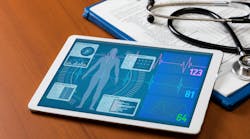In the past few years, personal fitness trackers have become all the rage. And no wonder: It’s fun to see your daily activity level, sleep quality, and heart rate. But, does knowing this data lead to any positive changes? What if the person looking over the data is your caregiver?
Those small fitness trackers were just the starting point for significant investment in wearables for patients. It won’t be long until hospitals introduce the soon-to-be ubiquitous world of “wearables” for the hospitalized patient.
In one example, a new wearable device aims to reduce pressure injuries for hospital patients, which annually affect more than 2.5 million people, according to Agency for Healthcare Research & Quality estimates. The small wireless device is placed on the patient’s chest and transmits data about their position, orientation, movement, and activity. Software then determines if the patient is due to be manually turned to reduce pressure points and the impaired blood flow that cause pressure ulcers. Compliance with regular turning is the key to improved outcomes. Let us examine the potential that wearable devices can offer hospitalized patients.
Published Clinical Trials for Wearable Devices
A large, randomized clinical trial of the wearable device noted above was conducted at Stanford Health Care in California and published in January 2018. In the LS-HAPI study, 1,312 ICU patients received either device-informed turning practices (treatment group) or traditional care (control group). Results showed fewer pressure injuries in the treatment group, 0.7% (five patients) vs. the control group, 2.3% (15 patients) P=0.031.
Even with clinically significant improvement, pressure ulcers still occurred in the treatment group. Current standards for turning the patient every two hours are more than 150 years old. Few studies have been conducted to validate or improve the current practice. Time will tell, as we're just beginning to understand how the technology and the data it generates can be used to improve and individualize turning protocols.
Interestingly, the wearable technology’s success could ultimately stem from how it influences behavior: It can serve as a gentle reminder for a typically low-ranking action in the nursing-task hierarchy. As a bonus, nurses may appreciate that it reduces their workloads by indicating if patients turn on their own, thus “resetting the clock.” Undeniably, for various reasons, current adherence to turning protocols is too low. Perhaps now that we can more objectively measure turning, we can further improve the performance of this basic intervention.
Leveraging Big Data
The trend toward wearable technology in clinical settings support the big data trend. Large data sets can be mined to reveal a patient’s patterns, trends, and associations. Data generated over time from wearables can be viewed retrospectively as part of a root-cause analysis or to determine compliance with standards in different units, shifts, populations, etc. Thus, aggregated data from inpatient wearables can be used to target areas for quality improvement initiatives and support the quest to eradicate hospital-acquired conditions.
Before jumping on the bandwagon, though, we should remember that the use of technology is rarely a substitute for good practice. I’ve seen this time and again in the prevention of nosocomial infections by using devices with antimicrobial coatings. Better-performing hospitals can often achieve very low infection rates simply by focusing on recommended best practices, sans technology. The technology may simply play a beneficial role in the overall plan, based on need and supporting evidence.
Increasing amounts of technology, including wearable sensors, big data, and smart algorithms, are clearly in our future. As I see it, they are just tools to be used in the care process; however, providers will still be the final arbiters for care decisions. As helpful tools, new technologies will allow us more time to focus on our strengths in the patient-care paradigm. In this way, technology-enabled care can improve patient safety.
Joe Cummings, Ph.D., is a senior associate at the Technology Assessment Program at Vizient. He brings his expertise to Vizient member organizations to stay at the forefront of medical-technology assessment, acquisition, management and rational clinical use. Topics of special interest include telemedicine, remote monitoring, neuromodulation, robotics and genomics. He also writes and presents frequently on technology forecasting, horizon-scanning, and the identification of innovative technologies.

